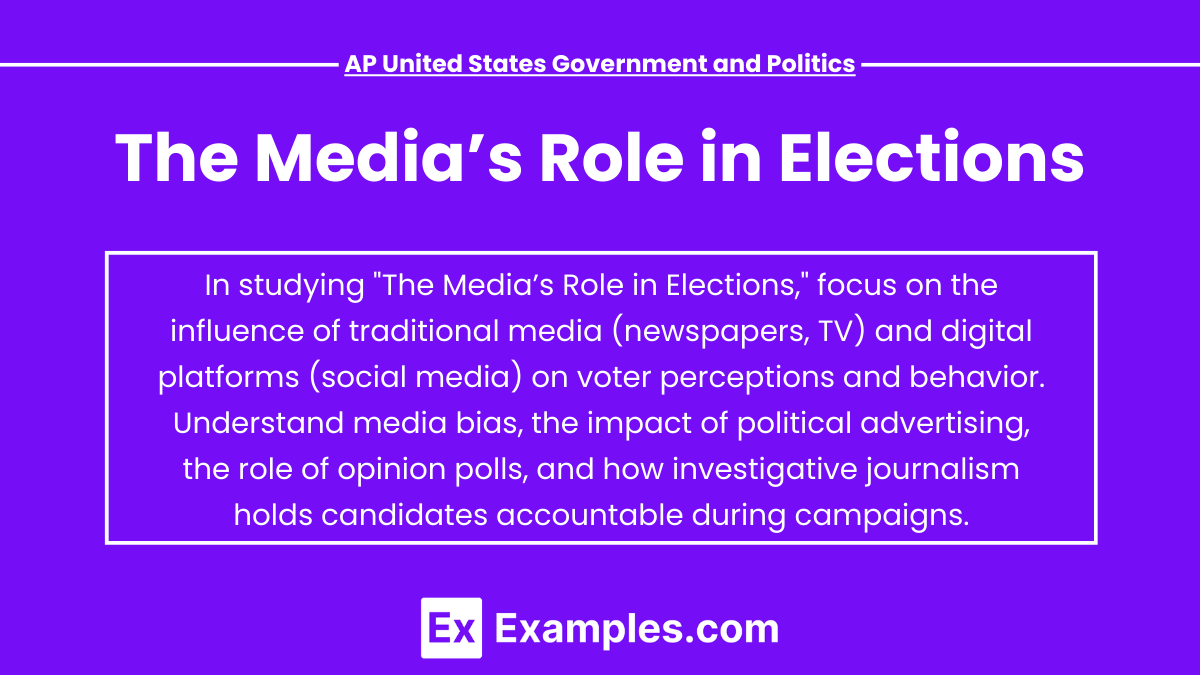The media plays a critical role in elections by shaping public perception, influencing voter behavior, and providing essential information about candidates and issues. From traditional outlets like newspapers and television to modern platforms like social media, the media serves as a primary source for political news and analysis. It not only informs the electorate but also acts as a watchdog, holding candidates accountable. Understanding the media's multifaceted influence is essential for grasping its significance in the democratic process and electoral outcomes.
Free AP United States Government and Politics Practice Test
Learning Objectives
In studying "The Media’s Role in Elections" for the AP United States Government and Politics exam, focus on defining key terms like political advertising and public opinion polling. Analyze how traditional and digital media influence public perceptions and candidate strategies. Assess the impact of social media on voter engagement, and explore the role of investigative journalism in holding candidates accountable. Understand how media coverage of polls affects voter behavior and discuss ethical considerations regarding biases and misinformation. These objectives will enhance your understanding of the media's influence in elections.
1. Information Dissemination
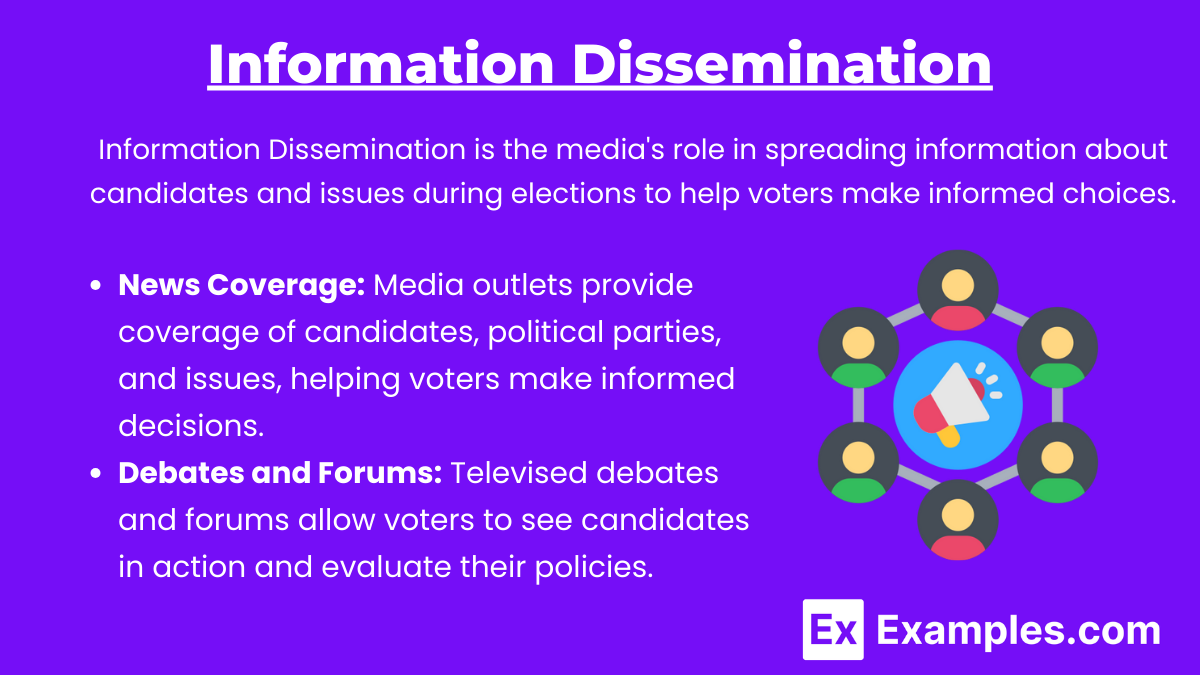
Information dissemination is crucial during elections, as it enables voters to access essential information about candidates and issues. Media outlets play a pivotal role in providing comprehensive coverage that influences voter decisions. Through news reports and debates, the electorate gains insights needed for informed participation.
News Coverage: Media outlets provide coverage of candidates, political parties, and issues, helping voters make informed decisions.
Debates and Forums: Televised debates and forums allow voters to see candidates in action and evaluate their policies.
2. Agenda Setting
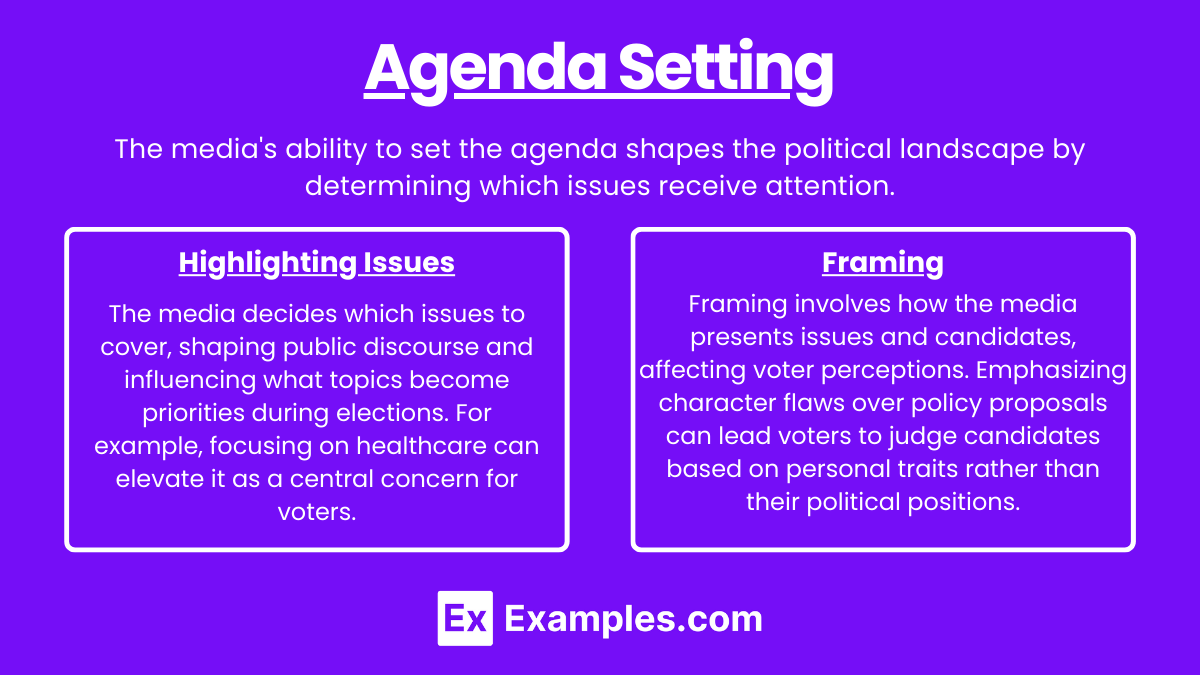
The media's ability to set the agenda shapes the political landscape by determining which issues receive attention. This process influences public discourse and prioritizes certain topics over others. By framing issues in specific ways, the media can significantly affect how voters perceive candidates and policies.
Highlighting Issues: The media determines which issues receive coverage, influencing public discourse and priorities.
Framing: How issues are presented (e.g., focusing on a candidate's character vs. policy) can shape voter perceptions.
3. Voter Mobilization
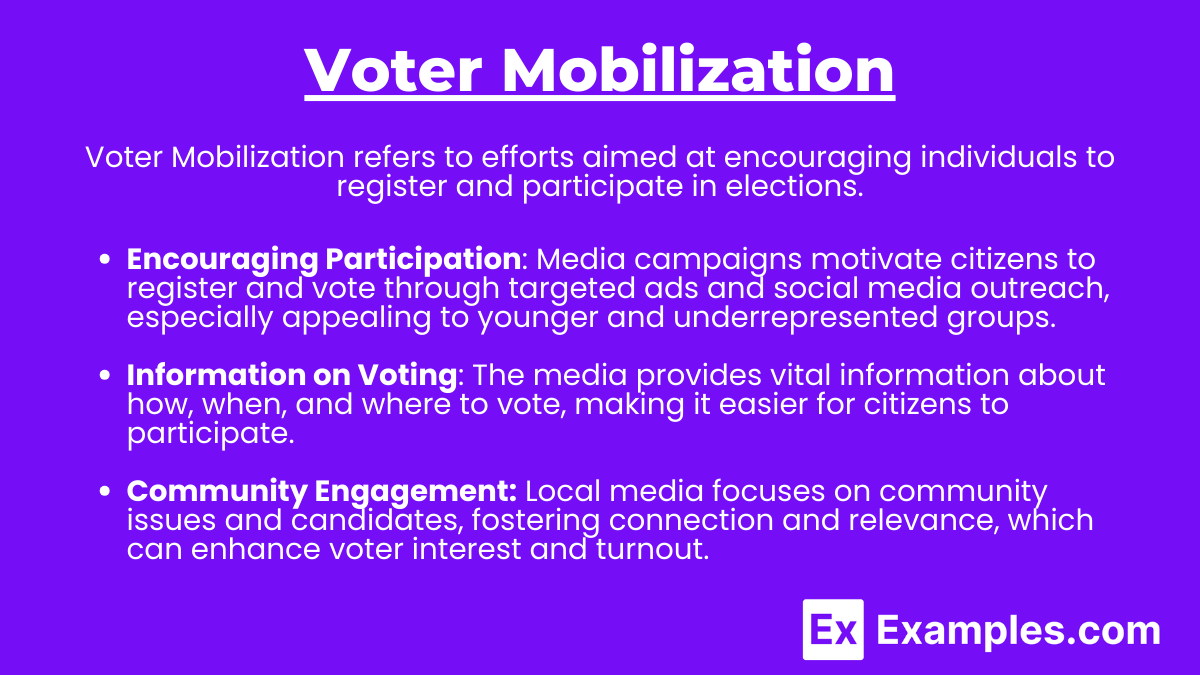
Voter Mobilization refers to efforts aimed at encouraging individuals to register and participate in elections. This involves activities that inform citizens about the voting process, promote the importance of voting, and engage them in the electoral system to increase voter turnout.
Encouraging Participation: Media campaigns motivate citizens to register and vote through targeted ads and social media outreach, especially appealing to younger and underrepresented groups.
Information on Voting: The media provides vital information about how, when, and where to vote, making it easier for citizens to participate.
Community Engagement: Local media focuses on community issues and candidates, fostering connection and relevance, which can enhance voter interest and turnout.
4. Influence of Social Media
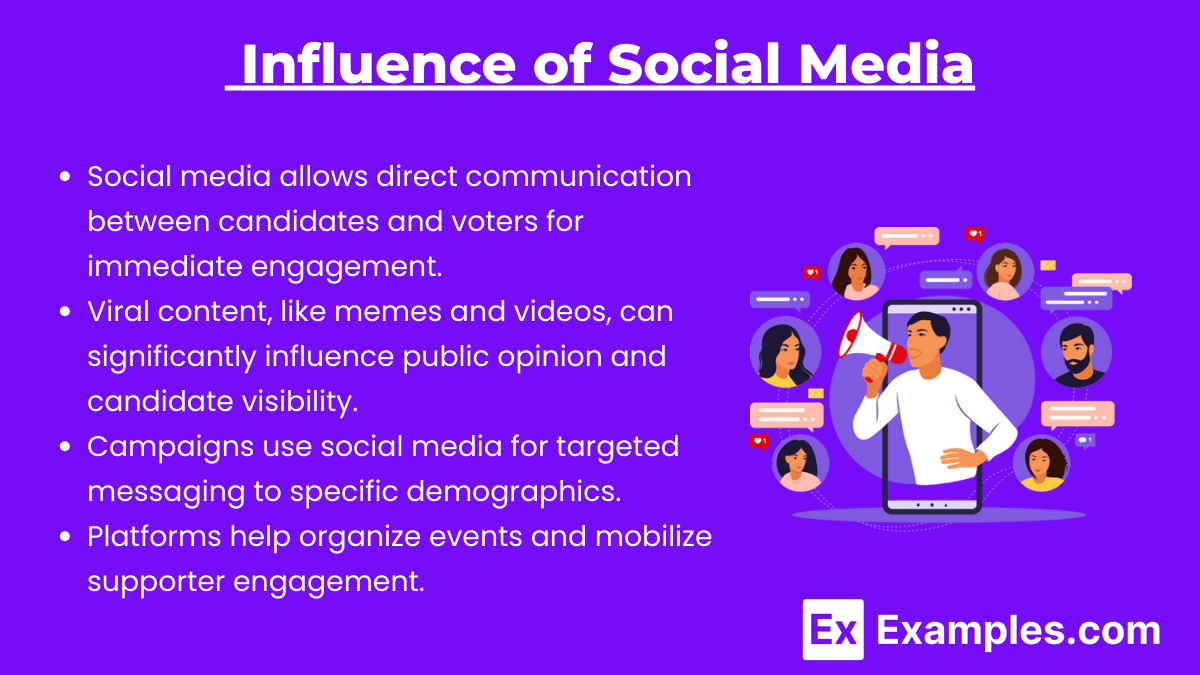
Social media has transformed how candidates communicate with voters, allowing for direct and immediate interaction. This shift enables candidates to bypass traditional media, creating a more personal connection with the electorate. Viral content can rapidly spread, influencing public opinion and engagement in real time.
Social media enables candidates to communicate directly with voters, allowing for immediate interaction and engagement without traditional media filters.
Content such as memes and videos can spread quickly on social media, significantly impacting public opinion and candidate visibility.
Campaigns can use social media to deliver tailored messages to specific demographics, enhancing the effectiveness of their outreach efforts.
Social media platforms facilitate the organization of events and volunteer opportunities, helping supporters engage and promote campaign messages.
However, the spread of false information and divisive narratives on social media can confuse voters and undermine trust in the electoral process.
5. Misinformation and Fake News
The rise of misinformation poses significant challenges in the electoral landscape, potentially distorting voter perceptions. As false information proliferates, it becomes essential for reliable media outlets to counteract these narratives. Fact-checking initiatives play a vital role in promoting accuracy and credibility.
Challenges: The rise of misinformation can confuse voters and skew perceptions of candidates and issues.
Fact-Checking: Some media outlets engage in fact-checking to combat false information and promote accuracy.
Examples
Example 1 : Televised Debates
Televised debates have become a cornerstone of electoral politics, providing a platform for candidates to present their views directly to voters. The 1960 Kennedy-Nixon debate is a historic example, showcasing how media can influence public perception. Kennedy's confident demeanor contrasted with Nixon's appearance, affecting voter impressions and ultimately contributing to Kennedy's victory. These debates remain crucial in shaping candidates' public images and informing voters about their positions.
Example 2 : Political Advertising
Political advertising is a powerful tool used by candidates to communicate their messages and sway public opinion. Campaigns utilize various media channels, including television, radio, and digital platforms, to run ads that promote their policies or attack opponents. For instance, Lyndon B. Johnson’s “Daisy” ad in 1964 leveraged emotional appeal to highlight the dangers of electing Barry Goldwater, illustrating the effectiveness of targeted advertising in influencing voter perceptions and electoral outcomes.
Example 3 : Social Media Engagement
The rise of social media has transformed political campaigning, enabling candidates to engage directly with voters. Platforms like Twitter, Facebook, and Instagram allow candidates to share messages, respond to criticisms, and mobilize supporters in real-time. Barack Obama’s 2008 campaign is a prime example, as he effectively used social media to connect with younger voters, driving high turnout and demonstrating how digital engagement can enhance voter participation in elections.
Example 4 : Opinion Polling Coverage
Media coverage of opinion polls provides valuable insights into voter sentiment and can shape electoral dynamics. Polls influence candidate strategies and public perceptions of electability. During the 2020 presidential election, the constant reporting of polling data created narratives around race competitiveness, impacting fundraising and campaign tactics. Voters may also adjust their preferences based on perceived momentum, showing how polling coverage can sway electoral outcomes.
Example 5 : Investigative Journalism
Investigative journalism serves as a crucial watchdog in the electoral process, holding candidates accountable and uncovering issues that may influence elections. A notable example is the Watergate scandal, which was exposed by investigative reporting from The Washington Post. This coverage not only revealed serious misconduct but also led to significant political consequences, including President Nixon's resignation. Investigative journalism ensures transparency, empowering voters with the necessary information to make informed decisions at the polls.
Multiple Choice Questions
Question 1
What was a significant impact of the 1960 Kennedy-Nixon debate on American elections?
A) It increased voter turnout significantly.
B) It demonstrated the influence of televised appearances on public perception.
C) It led to new regulations on campaign financing.
D) It eliminated the need for political advertising.
Answer: B) It demonstrated the influence of televised appearances on public perception.
Explanation: The 1960 Kennedy-Nixon debate highlighted how candidates' appearances and demeanor could significantly affect voter perceptions. Kennedy's confident performance contrasted with Nixon's less favorable image, influencing public opinion and showcasing the importance of media in shaping electoral outcomes.
Question 2
Which of the following best describes the role of political advertising in elections?
A) It is primarily used to provide unbiased news coverage.
B) It helps candidates communicate their messages and sway public opinion.
C) It focuses solely on criticizing opponents without promoting any policies.
D) It is no longer relevant in the age of social media.
Answer: B) It helps candidates communicate their messages and sway public opinion.
Explanation: Political advertising is a critical tool for candidates to reach voters and present their platforms. It can highlight policies, attack opponents, and create narratives that shape public opinion. Effective political ads can significantly influence voter perceptions and decisions.
Question 3
How has social media changed the landscape of political campaigning?
A) It has reduced the importance of televised debates.
B) It allows candidates to engage directly with voters in real-time.
C) It has made political advertising obsolete.
D) It eliminates the need for traditional media outlets.
Answer: B) It allows candidates to engage directly with voters in real-time.
Explanation: Social media has transformed political campaigning by enabling direct interaction between candidates and voters. Candidates can share messages, respond to feedback, and mobilize supporters quickly, enhancing voter engagement and participation. This real-time communication is a significant shift from traditional campaign methods.

